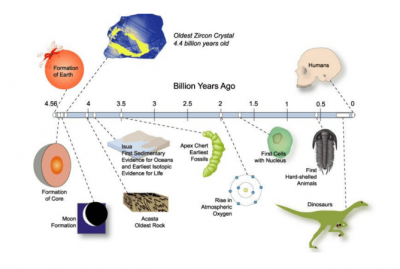
|
Just as the day is divided into hours, minutes and seconds, geologists divide Earth’s history into time periods. The longest divisions are aeons, which are billions of years long; the shortest are chrons, a few thousand years long. In between come eras, periods, epochs and ages. Scientists divide the last 590 million years into three eras: the Palaeozoic (meaning ‘old life’), Mesozoic (‘middle life’), and Cenozoic (‘new life’). |
Humans have only been a species in the most recent chapter of the history of Earth. The Earth was formed 4.6 billion years ago, when the sun in our solar system first formed, creating enough gravitational pull to spin planets into orbit. But how do scientists know how old the Earth is if humans weren’t around back when it was formed? When was life first formed on this planet? And what are the paths that life has taken so far over the course of that existence? This lesson will teach about the ages that make up the history of life on Earth, and explore the many changes and forms life has taken in its time on this planet.
Timeline of Geological Eras
The geological timeline of Earth is nearly identical to the history of life on Earth, apart from the Hadean Era. This is because the geological timeline, or the order of geological events, such as oceans forming, volcanoes erupting, how long deserts lasted, and tectonic plate movement, all happened in sequence with the life that has existed on this planet. The history of both life and the geological timeline is arranged within 5 subgroups, arranged from the largest span of time to the smallest: eons, eras, periods, epochs, and ages. To understand the timeline of life that has existed on Earth, it is important to understand how scientists determine the age of both rocks and the remnants of living things, otherwise known as fossils.
Because humans were not around 4.6 billion years ago to record the beginnings of our planet, scientists must rely on evidence from geological and fossil records in order to determine the relative age of both the planet and the life that exists here. Both the geological timeline and the age of life are determined in much the same way. Modern scientists rely on what is called radioactive dating to determine an accurate and precise age of both rocks and fossils. Radioactive dating measures the rate of decay of an element in a rock or in a fossil. Carbon-14 is typically used when dating fossils because all living things are carbon-based, and the flow of carbon can be tracked through the carbon cycle. For geological objects such as rocks and minerals, Rubidium-87 and Potassium-40 are often used. By knowing how long it takes for molecules in an object to decay, scientists can calculate when the object’s half-life is. The half-life of an object refers to the amount of time it would take for half of an amount of a substance to radioactively decay, or break down. If the half-life of an object is known, it is possible to calculate when the object was first created, when no decay is evident.
Credit: study.com
Picture credit: Google




